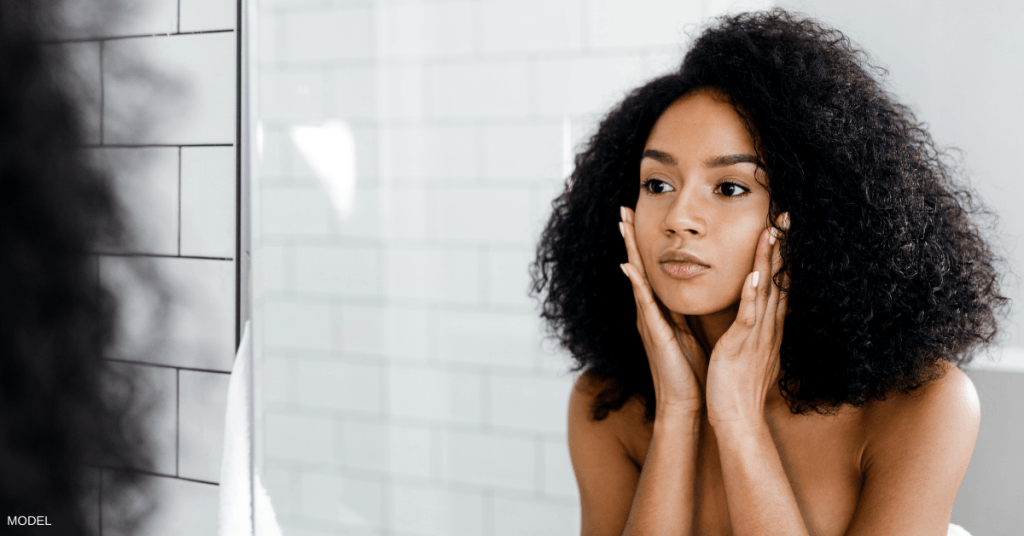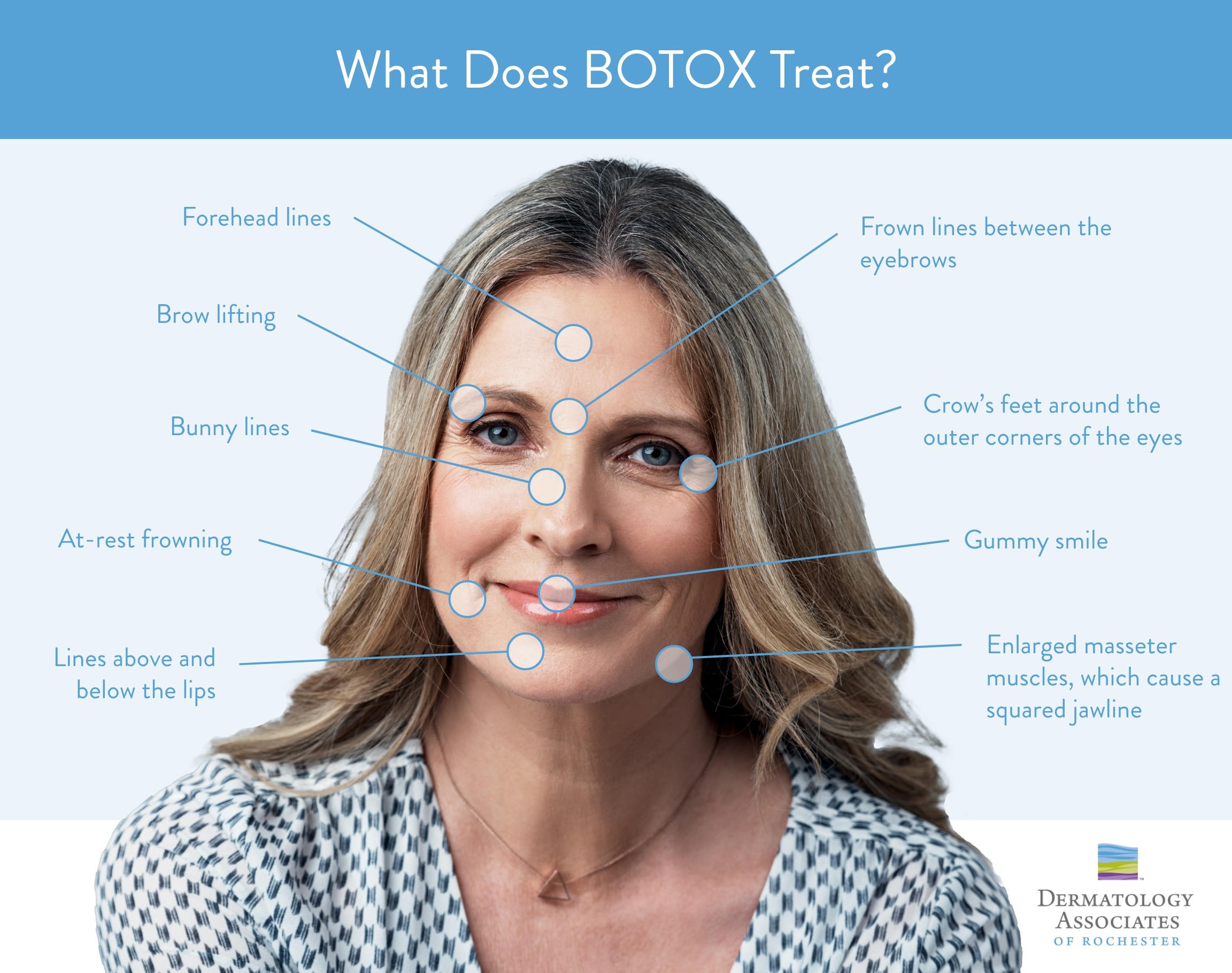It may be hard to believe, but BOTOX itself is creeping up in years. Now synonymous with anti-wrinkle injections, BOTOX first received approval from the FDA as a temporary aesthetic treatment to reduce worry lines in April 2002. Twenty years later, BOTOX is the most popular cosmetic treatment in the world and is approved to treat a range of conditions. It’s certainly popular among the women and men who get BOTOX at our practice near Brighton, NY.
To mark this milestone anniversary, we’ve created a refresher for patients who may be considering BOTOX for the first time or people who want to learn about its many uses. From reducing gummy smiles to creating a lip flip with BOTOX, our injectors use their expertise in a number of ways.
BOTOX: The Basics
BOTOX belongs to a category of medications called neuromodulators. When it’s injected into the face or neck, the active ingredient temporarily relaxes muscles whose movements cause the development of lines and wrinkles. These are sometimes called expression lines because they develop when we change facial expressions, such as squinting, frowning, or appearing surprised. It’s important, however, that you choose an injector with the expertise to target facial muscles with precision—and who understands the amount of BOTOX to inject—to avoid unwanted side effects.
BOTOX Alternatives
In the 20 years since BOTOX first received FDA approval as an anti-wrinkle treatment, several competitors have emerged in the U.S. The BOTOX alternatives most widely used by dermatologists and other aesthetic specialists include:
- Dysport®
- Xeomin®
- Jeuveau®
BOTOX and the other three products all share the same active ingredient, but each has unique differences that might make one option a more appropriate choice in certain situations. Dysport, for example, is slightly less potent than BOTOX and can spread farther from the injection site, which may make it suitable for treating larger areas of the skin.
BOTOX Side Effects
Even though all cosmetic treatments include some risk of unwanted side effects, BOTOX has an excellent track record of safety. Minor side effects include soreness at the injection site, which resolves on its own within a day. More serious issues, such as droopy eyelids or results that make your face appear frozen, are rare and often caused by injectors without adequate training. Even these side effects, though, are temporary.
You can minimize the risk of experiencing side effects by informing the provider about any medications, antibiotics, or supplements you are taking and disclosing your entire medical history.
How Much Does BOTOX Cost?
Providing an estimated cost for BOTOX treatments (or procedures using alternative products) is difficult because each patient has specific needs and aesthetic goals. It’s important to understand how a practice charges for BOTOX injections. Dermatology Associates of Rochester charges patients per unit of BOTOX, which we believe is a more transparent method than charging based on the treatment area, as some other practices do.
What Does BOTOX Treat?
The versatility of BOTOX and other neuromodulators is one of the reasons they are so popular. They effectively treat a range of patient concerns besides wrinkles. Treatment areas include:
- Frown lines between the eyebrows, also called glabellar lines or “11s”
- Crow’s feet around the outer corners of the eyes
- Forehead lines
- At-rest frowning
- Brow lifting
- Gummy smile
- Bunny lines on the nose
- Enlarged masseter muscles, which cause a squared jawline
- Neck bands
- Lines above and below the lips
BOTOX is also approved by the FDA for a number of non-cosmetic uses, including reducing excessive underarm sweating and as a treatment for chronic migraine headaches.
BOTOX Lip Flip vs. Lip Fillers
One of the recent treatment trends has been using BOTOX to create the appearance of fuller upper lips. Typically, lip augmentation has been accomplished using lip fillers, such as JUVEDERM VOLBELLA® XC, Restylane® Silk, and RHA 2. These hyaluronic acid dermal fillers add volume and hydration to the lips, creating a more youthful and sensuous appearance.
A lip flip with BOTOX makes your lips appear fuller without increasing the volume of the lips. A provider injects BOTOX into the upper lip, relaxing the muscle above the lip. This results in the upper lip “flipping” upwards, creating the illusion of a fuller lip.
Which is better? It depends on the patient’s goals. A BOTOX lip flip won’t create the overfilled look that sometimes occurs with lip fillers because it doesn’t add any volume. For patients with very thin lips, though, augmentation with fillers is probably a better option. The effects of BOTOX last about 3 to 4 months; lip fillers will last 9 months or more in most cases.
Do BOTOX Injections Hurt?
Patients experience minimal discomfort during the injections. Applying an anesthetic cream before the injections numbs the treatment area, and the only sensation is a brief pinch. BOTOX treatments typically take only about 10 to 15 minutes.
What Happens After BOTOX Treatments?
There is no downtime needed after a BOTOX appointment, but there are some things to know about post-injection care. Most patients see the effects of BOTOX about 7 days after the treatment. Follow-up treatments may be recommended to fine-tune the results.
After the injections, you should:
- Avoid rubbing the treatment area for 4 hours
- Postpone strenuous exercise for 24 hours
- Keep your head elevated for 4 hours
The results of BOTOX treatments typically last for about 4 months.
Schedule a Consultation
If you’re interested in getting BOTOX, Dysport, or XEOMIN injections, request a consultation using the online form to meet with one of our providers or call us at (585) 272-0700 to schedule an appointment.




Leave a Reply